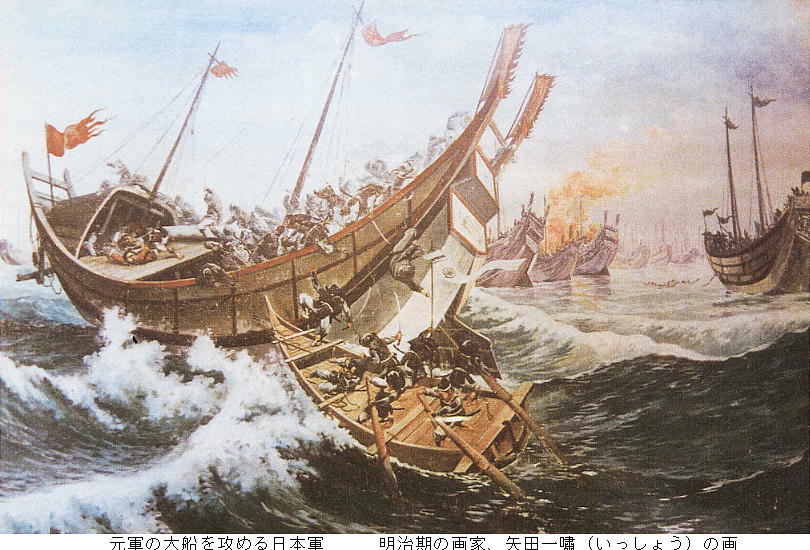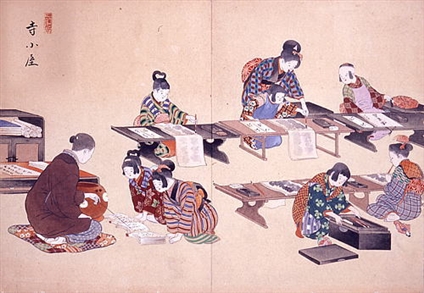A Tokyo Subway Station
Nobunaga and Jesuit Missionaries to Japan
One of the most popular or interesting historical characters of Japan is Oda Nobunaga (1534-1582).
Oda Nobunaga was a powerful daimyo of Japan in the late 16th century who attempted to unify Japan during the late Sengoku period.
The goal of national unification and a return to the comparative political stability of the earlier Muromachi period was widely shared by the multitude of autonomous daimyo during the Sengoku period. Oda Nobunaga however, was the first for which this goal seemed attainable. Nobunaga had gained control over most of Honshu (see map below), before his death during the 1582 Honnō-ji incident, a coup attempt executed by Nobunaga's vassal, Akechi Mitsuhide. It is not certain if Nobunaga was killed in the attack or if he committed seppuku. The motivation of Mitsuhide's betrayal was never revealed to anyone who survived the incident, and has been a subject of debate and conjecture ever since the incident.The era Nobunaga lived in was at the end of the age of provincial wars in Japan. At the time, since the samurai class had taken political power from the imperial court, more than 300 years had passed.
https://en.wikipedia.org/wiki/Oda_Nobunaga
The first samurai regime, the Kamakura feudal government, collapsed in 1333、and then the second samurai regime, the Muromachi feudal government, established in Kyoto in 1336, came to lose ruling power since the end of the 15th century. Samurai feudal lords, called daimyos, independently occupied local territories while the emperor and the Muromachi shogun in Kyoto had no political power. Japan had no unified power center, and this era was called the age of provincial wars. The concern was who among powerful daimyos would unify Japan again with his military power and become a new shogun, a kind of king of the samurai class.
In this situation, the first daimyo who looked like having power to unify Japan again was Oda Nobunaga originally from a region near Nagoya. Nobunaga adopted, in a large scale, harquebuses or primitive rifles sailors of a wrecked Portuguese ship brought to Japan. His army defeated troops of rival daimyos one after another. Nobunaga actually occupied Kyoto, which was going to pave the way for establishing his hegemony all over Japan. He had already occupied most of the regions east of Kyoto, which is called the central Japan today, but some powerful daimyos with territories in west of Kyoto would not surrender to Nobunaga. So, Nobunaga decided to launch a big military campaign with tens of thousands of samurai troops equipped with thousands of harquebuses.
But at night before starting from Kyoto, he was attacked and killed by one of his generals who mobilized 15,000 soldiers to surround a temple near Kyoto where Nobunaga happened to stay with just 150 entourage samurais.
So, though Nobunaga did not unify Japan or did not become a shogun or a top leader of all the samurais, his remarkable success of having occupied almost half of Japan by his military power made him a hero in the history, though he was originally a daimyo with a small territory around Nagoya. It is also because almost for preceding 100 years no daimyos had come so close to unification of Japan like Nobunaga.
His popularity also came from his unique personality. Nobunaga was so revolutionary in his way of thinking and behaviors. That is why he adopted, in a large scale, the fire arms newly introduced to Japan by Europeans. Nobunaga was also interested in Christian missionaries who started to come to Japan at the time. Those Catholic missionaries brought some unique or advanced products to Japan in addition to information of the world. Nobubaga loved them. So, he allowed European missionaries to be engaged in their missionary work in his territory. In fact, some Christian churches were built even in Kyoto of the 15h century under protection of Nobunaga.
Some missionaries wrote about Nobunaga in their diaries or letters as they were also so impressed by this rising future samurai king. But as they came to know Nobunaga more, they started to be worried by strong samurai leader Nobunaga. He loved Western products and liked to get information of the world from European priests, but he did not believe Christianity. He was not even interested in the teaching of the Bible. He was a kind of abusing Catholic missinaries.
So, according to one theory, some Jesuit missionaries found evil force in Nobunaga. They decided to kill Nonbunaga. And, eventually, they worked behind the scene of the assassination of Nobunaga in Hon-noji Temple in 1582. But their plan was carried out so secretly. Even Akechi Mitsuhide, one of Nobunaga's general who attacked and killed Nobunaga, did not realize why and how he could get a chance to take over power from Nobunaga who had sometimes insulted Mitsuhide enough to incur Mitsuhide's hatred.
The tragedy that Nobunaga was assassinated while he was about to seize hegemony all over Japan contributed to his popularity. He looks like a kind of tragic hero. He looks quite different from any other heroes in the Japanese history. There is something in Nobunaga that appeals to the minds of Japanese people. He was revolutionary in his mind set though he was so cruel in battle fields. He must have looked very differently to different people even while Nobunaga was living. And to some Jesuit missionaries, Nobunaga might have looked so dangerous to their future mission in Japan. Maybe they worked secretly for the assassination of Nobunaga.
Even in Europe, in the late 16th century, the Vatican tried to assassinate Queen Elizabeth I who executed Mary, Queen of Scots.
Indeed, the world was so bloody in the 16th century. So, Oda Nobunaga, the rising samurai daimyo in Japan who was abusing Catholic missionaries, might have been assassinated with involvement of Jesuit priests, though there has been no concrete evidence so far.

Oda Nobunaga
https://ja.wikipedia.org/wiki/%E7%B9%94%E7%94%B0%E4%BF%A1%E9%95%B7

A book on Nobunaga and Missionary Luís Fróis
https://www.amazon.co.jp/%E5%AE%8C%E8%A8%B3%E3%83%95%E3%83%AD%E3%82%A4%E3%82%B9%E6%97%A5%E6%9C%AC%E5%8F%B2%E3%80%882%E3%80%89%E4%BF%A1%E9%95%B7%E3%81%A8%E3%83%95%E3%83%AD%E3%82%A4%E3%82%B9%E2%80%95%E7%B9%94%E7%94%B0%E4%BF%A1%E9%95%B7%E7%AF%87-2-%E4%B8%AD%E5%85%AC%E6%96%87%E5%BA%AB-%E3%83%AB%E3%82%A4%E3%82%B9-%E3%83%95%E3%83%AD%E3%82%A4%E3%82%B9/dp/4122035813?ie=UTF8&*Version*=1&*entries*=0
**** **** ****
Joh 6:9 There is a lad here, which hath five barley loaves, and two small fishes: but what are they among so many?
Joh 6:10 And Jesus said, Make the men sit down. Now there was much grass in the place. So the men sat down, in number about five thousand.
Joh 6:11 And Jesus took the loaves; and when he had given thanks, he distributed to the disciples, and the disciples to them that were set down; and likewise of the fishes as much as they would.







